Pegasus constellation lies in the northern hemisphere. It is one of the largest constellations in the sky.
It was first catalogued by the Greek astronomer Ptolemy in the 2nd century. The constellation was named after Pegasus, the winged horse in Greek mythology.
The constellation is known for the Great Square of Pegasus, a familiar asterism in the northern sky, as well as for a number of bright stars and deep sky objects, among them Messier 15 (NGC 7078), NGC 7331, Stephan’s Quintet of galaxies, the Einstein Cross (a gravitationally lensed quasar), and the unbarred spiral galaxy NGC 7742.
Facts, location and map
Pegasus is the seventh largest constellation in the sky, occupying an area of 1121 square degrees. It is located in the fourth quadrant of the northern hemisphere (NQ4) and can be seen at latitudes between +90° and -60°. The neighboring constellations are Andromeda, Aquarius, Cygnus, Delphinus, Equuleus, Lacerta, Pisces and Vulpecula.
The constellation name Pegasus is pronounced /ˈpɛɡəsəs/. In English, the constellation is known as Pegasus or the Winged Horse. The genitive form of Pegasus, used in star names, is Pegasi (pronunciation: /ˈpɛɡəsaɪ/). The three-letter abbreviation, adopted by the International Astronomical Union (IAU) in 1922, is Peg.
Pegasus belongs to the Perseus family of constellations, along with Andromeda, Auriga, Cassiopeia, Cepheus, Cetus, Lacerta, Perseus, and Triangulum.
Pegasus contains a Messier object – Messier 15 (NGC 7078, Cumulo de Pegaso) – and has nine stars with confirmed planets. The brightest star in the constellation is Enif, Epsilon Pegasi, with an apparent magnitude of 2.399. There is one meteor shower associated with Pegasus; the July Pegasids.
The constellation contains 15 formally named stars. The star names approved by the International Astronomical Union (IAU) are Algenib, Alkarab, Anadolu, Biham, Enif, Helvetios, Homam, Markab, Matar, Morava, Sadalbari, Salm, Scheat, Solaris, and Tangra.
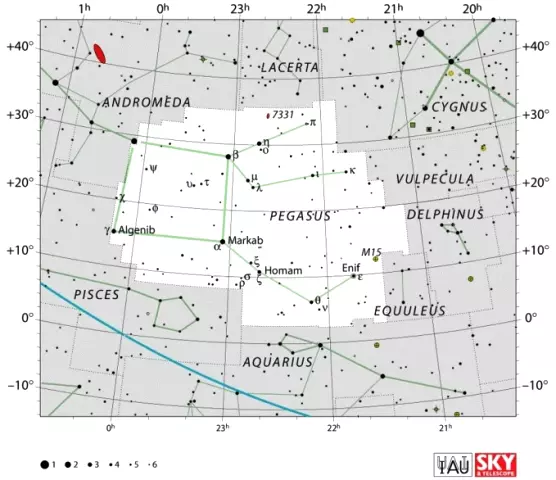
Pegasus constellation map by IAU and Sky&Telescope magazine
Pegasus myth
In Greek mythology, Pegasus is a white winged horse that sprang from the neck of the Gorgon Medusa when Perseus beheaded her. Medusa was a beautiful young woman before she was turned into a monster by the goddess Athena after being caught being defiled by the sea god Poseidon in the goddess’ temple. Athena turned Medusa’s hair into snakes and made her face so ugly that anyone who looked at her immediately turned to stone.
Perseus was sent to defeat Medusa by King Polydectes of Seriphus, who was the brother of Dictys, the man who took Perseus and his mother Danaë in and raised Perseus as his own son. Polydectes wanted Danaë for himself and Perseus stood in his way because he defended his mother from the king’s advances. He did not expect the hero to come back from his mission alive.
When Perseus defeated Medusa, Pegasus and the warrior Chrysaor sprang from her neck, both of them offspring of Poseidon.
The name Pegasus is derived from the Greek pegai which means “springs” or “waters,” and Chrysaor’s name means “the golden sword.”
When he was born, Pegasus flew away to Mount Helicon in Boeotia, where the Muses lived, and he befriended them. He created a spring that was named Hippocrene by striking the ground with his hoof. The name Hippocrene means “the horse’s fountain.” It was said that those who drank from the spring were blessed with the gift to write poetry.
The most famous myth involving Pegasus is the one of Bellerophon, the hero who was sent by King Iobates of Lycia to defeat the Chimaera, a monster that breathed fire and was devastating the king’s land. Bellerophon found Pegasus and tamed him using a golden bridle given to him by the goddess Athena. Then he swooped down on the Chimaera from the sky and defeated the monster with his lance and arrows. After this and several other heroic deeds for King Iobates, Bellerophon let the successes get to his head. Riding Pegasus, he tried to fly to Olympus and join the gods. He didn’t succeed. He fell off the horse and back to Earth.
Pegasus did however make it to Olympus. There, Zeus used the horse to carry his thunder and lightning, and eventually placed him among the constellations. The constellation Pegasus is depicted with only the top half of the horse, and it is nevertheless one of the largest constellations in the sky, seventh in size.
Asterisms
The Great Square of Pegasus
The Great Square of Pegasus represents the main body of Pegasus. It is a prominent asterism made up of three bright stars in Pegasus and Alpha Andromedae, which in ancient times was considered to belong to both Pegasus and Andromeda constellations and marked both the navel of the horse and the top of Andromeda’s head.
In the 17th century, Johann Bayer gave the star a dual designation, Alpha Andromedae and Delta Pegasi. The name Delta Pegasi has long been retired and the star is now known only as Alpha Andromedae, or by its proper name, Alpheratz.
The other stars that form the Great Square of Pegasus are Markab (Alpha Pegasi), Scheat (Beta Pegasi), and Algenib (Gamma Pegasi).
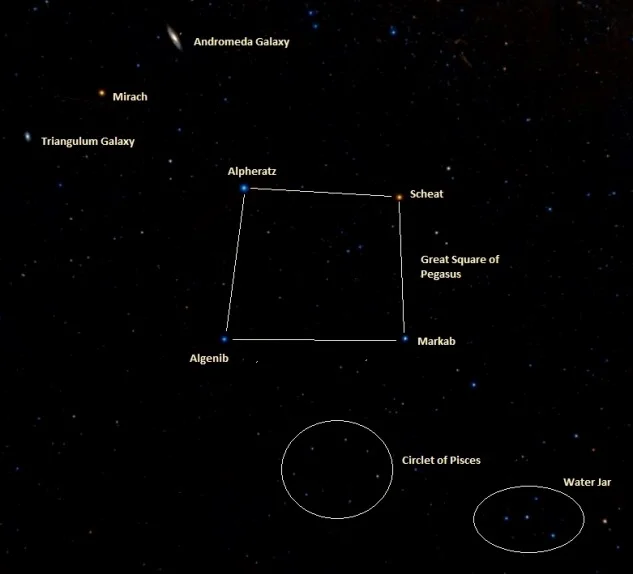
The Great Square of Pegasus, the Circlet of Pisces and the Water Jar, image: Wikisky
Pegasus stars
Markab – α Pegasi (Alpha Pegasi)
Alpha Pegasi is giant star belonging to the spectral class B9 III. It has an apparent magnitude of 2.48 and is approximately 133 light years distant. It is only the third brightest star in Pegasus. It has a radius almost five times that of the Sun.
The star’s traditional name comes from the Arabic word markab, which means “the saddle of the horse.”
Scheat – β Pegasi (Beta Pegasi)
Beta Pegasi is the second brightest star in the constellation. It has the stellar classification M2.3 II-III, which means that it is a red star halfway between the subgiant and giant stage. It is about 1500 times more luminous than the Sun.
The traditional name, Scheat, comes from the Arabic Al Sā’id, which means “the upper arm.”
Beta Pegasi has an apparent magnitude of 2.42 and is about 196 light years distant. It is classified as a semi-regular variable star with a period of 43.3 days. Its brightness ranges from magnitude 2.31 to 2.74. The star is losing mass and as a result it has a shell of gas and dust that is expanding with a radius of about 3500 times that of the Sun.
Algenib – γ Pegasi (Gamma Pegasi)
Algenib is a subgiant star of the spectral type B2 IV. It has a visual magnitude of 2.84 and is approximately 390 light years distant. It marks the lower left-hand corner of the Great Square of Pegasus.
Gamma Pegasi is classified as a Beta Cephei variable, which means that its variations in brightness can be attributed to pulsations of the star’s surface. It has a radial pulsation period of 0.15175 days during which its brightness varies from 2.78 to 2.89.
Algenib is almost nine times as massive as the Sun and has about five times the solar radius. It is 5840 times more luminous than the Sun.
Enif – ε Pegasi (Epsilon Pegasi)
Epsilon Pegasi is the brightest star in Pegasus. It has a visual magnitude of 2.399 and is approximately 690 light years distant from the Sun. Its traditional name, Enif, comes from the Arabic word for “the nose.” The star marks Pegasus’ muzzle.
Enif belongs to the spectral class K2 Ib. This means that it is an orange supergiant. It is 12 times more massive than the Sun, about 5000 times more luminous, and it has 185 times the Sun’s radius.
Epsilon Pegasi is classified as a LC type slow irregular variable. It varies from 0.7 to 3.5 in magnitude. The star’s spectrum shows an overabundance of barium and strontium. The star is also notable for having a relatively high peculiar velocity (true velocity) of 21.6 km/s.
Homam – ζ Pegasi (Zeta Pegasi)
Zeta Pegasi is a main sequence star of the spectral type B8 V. It has an apparent magnitude of 3.414 and is about 204 light years distant from the Sun. It has four times the solar radius.
The star is classified as a slowly pulsating B star with slight variations in luminosity. It has a period of 22.952± 0.804 hours and completes 1.04566 cycles per day.
Zeta Pegasi is a rapid rotator, with an estimated rotational velocity between 140 and 210 km/s. It has two visual companions, a magnitude 11.6 star 68 arc seconds away and an 11th magnitude star 177 arc seconds away.
The star’s traditional name, Homam, means “the lucky star of the high minded” or “man of high spirit.”
Matar – η Pegasi (Eta Pegasi)
Eta Pegasi is a double star approximately 167 light years distant from the solar system. It has a visual magnitude of 2.95 and is the fifth brightest star in the constellation.
It is composed of two stars that orbit each other with a period of 813 days. The brighter component in the system is a bright giant of the spectral type G2 II, four times more massive and 247 times more luminous than the Sun. The companion is a main sequence star belonging to the spectral class F0 V. The name Matar comes from the Arabic phrase Al Saʽd al Maṭar, which means “the lucky star of rain.”
Baham – θ Pegasi (Theta Pegasi)
Theta Pegasi belongs to the spectral class A2 Vp and is about 67 light years distant from Earth. It has a visual magnitude of 3.53. It is 25 times more luminous than the Sun and has 2.6 times the solar radius.
Sadalbari – μ Pegasi (Mu Pegasi)
Mu Pegasi is a yellow giant star of the spectral type G8 III. It has a visual magnitude of 3.514 and is 106.1 light years distant. It has a radius almost ten times solar, but is only slightly more massive than the Sun, about 2.7 times.
The star’s traditional name, Sadalbari, comes from the Arabic phrase for “luck star of the splendid one.”
51 Pegasi
51 Pegasi is a main sequence star similar to the Sun, approximately 50.9 light years distant from Earth. It belongs to the spectral class G5V and has an apparent magnitude of 5.49.
51 Pegasi was the first star ever discovered that was similar to the Sun and had a planet in its orbit. The star has a radius 24% larger than the Sun and is 11% more massive. It is also older than the Sun, with an estimated age between 6.1 and 8.1 billion years.
The exoplanet, 51 Pegasi b, was discovered on October 6, 1995. It has at least half the mass of Jupiter. The planet was nicknamed Bellerophon.
IK Pegasi
IK Pegasi is a double star approximately 150 light years distant. It has a visual magnitude of 6.078. The two stars in the system have an orbital period of 21.7 days. The brighter component is a main sequence star of the spectral type A8m. It is classified as a Delta Scuti variable and its variation cycle repeats itself 22.9 times a day.
The companion star, IK Pegasi B, is a white dwarf. It is the nearest supernova progenitor candidate known, and will eventually go out as a Type Ia supernova once the brighter star in the system evolves into a red giant and grows a radius that allows the white dwarf to accrete matter from its expanded gaseous envelope.
Deep sky objects in Pegasus
Messier 15 (M15, NGC 7078)
Messier 15 is a globular cluster, about 18 arc minutes in size. It has an apparent magnitude of 6.2 and is about 33,600 light years distant. With an absolute magnitude of -9.2, M15 is 360,000 times brighter than the Sun. The brightest stars in the cluster are of magnitude 12.6.
The cluster was discovered by the Italian-born astronomer Jean-Dominique Maraldi in 1746, and included in Charles Messier’s catalogue in 1764.
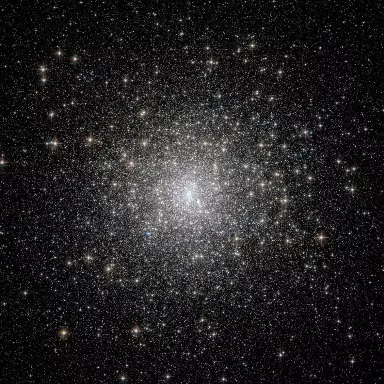
Messier 15 is a globular cluster — a spherical conglomeration of old stars that formed together from the same cloud of gas, found in the outer reaches of the Milky Way in a region known as the halo and orbiting the Galactic Centre. This globular lies about 35 000 light-years from the Earth, in the constellation of Pegasus (The Flying Horse). Messier 15 is one of the densest globulars known, with the vast majority of the cluster’s mass concentrated in the core. Astronomers think that particularly dense globulars, like this one, underwent a process called core collapse, in which gravitational interactions between stars led to many members of the cluster migrating towards the centre. Messier 15 is also the first globular cluster known to harbour a planetary nebula, and it is still one of only four globulars known to do so. The planetary nebula, called Pease 1, can be seen in this image as a small blue blob to the lower left of the globular’s core.
This picture was put together from images taken with the Wide Field Channel of Hubble’s Advanced Camera for Surveys. Images through yellow/orange (F606W, coloured blue) and near-infrared (F814W, coloured red) filters were combined. The total exposure times were 535 s and 615 s respectively and the field of view is 3.4 arcminutes across. Image: ESA/Hubble & NASA
M15 is believed to be 12 billion years old, which makes it one of the oldest globular clusters known. It contains more than 100,000 stars, among them a significant number of variables and pulsars, including the double neutron star M15 C.
The cluster is also home to Pease 1, a planetary nebula discovered in 1928. Pease 1 was the first planetary nebula discovered within a globular cluster. The nebula has an apparent magnitude of 15.5.
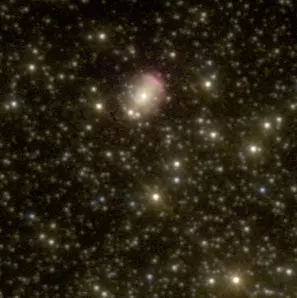
Pease 1, image: NASA
M15 also contains two bright x-ray sources, Messier 15 X-1 and Messier 15 X-2.
Stephan’s Quintet (HCG 92, Arp 319)
Stephan’s Quintet is a group of five galaxies, NGC 7317-7320, first discovered by the French astronomer Édouard Stephan at Marseilles Observatory in 1877. They lie about 280 million light years from Earth. The visual grouping was one of the first targets of NASA’s James Webb Space Telescope (JWST) in 2022.
Four of the five galaxies were the first compact galaxy group ever discovered. The brightest galaxy in the group is NGC 7320, which is only 40 million light years distant. The other four galaxies in the group form a physical association, the Hickson Compact Group 92, and will eventually merge.
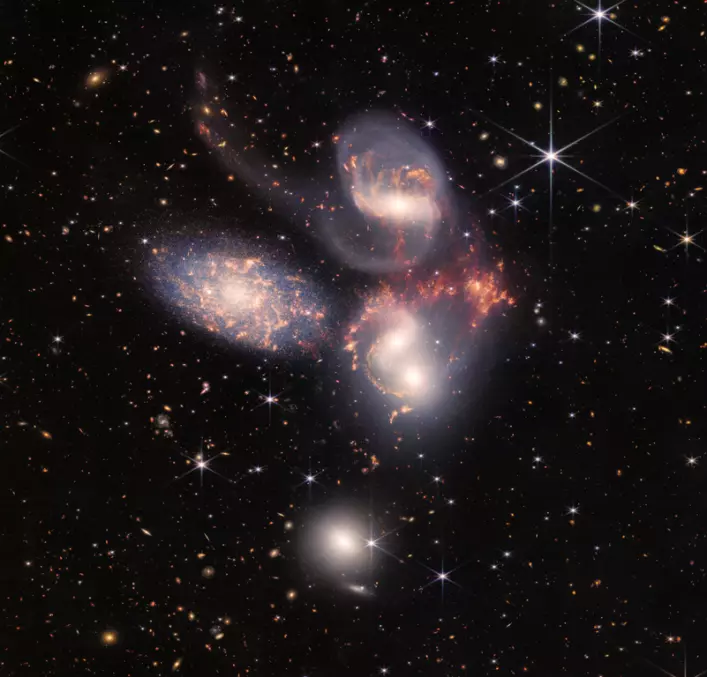
With its powerful, infrared vision and extremely high spatial resolution, Webb shows never-before-seen details in this galaxy group. Sparkling clusters of millions of young stars and starburst regions of fresh star birth grace the image. Sweeping tails of gas, dust and stars are being pulled from several of the galaxies due to gravitational interactions. Most dramatically, Webb’s MIRI instrument captures huge shock waves as one of the galaxies, NGC 7318B, smashes through the cluster. These regions surrounding the central pair of galaxies are shown in the colors red and gold. This composite NIRCam-MIRI image uses two of the three MIRI filters to best show and differentiate the hot dust and structure within the galaxy. MIRI sees a distinct difference in color between the dust in the galaxies versus the shock waves between the interacting galaxies. The image processing specialists at the Space Telescope Science Institute in Baltimore opted to highlight that difference by giving MIRI data the distinct yellow and orange colors, in contrast to the blue and white colors assigned to stars at NIRCam’s wavelengths. Credit: NASA, ESA, CSA, STScI
NGC 7320
NGC 7320 is a spiral galaxy 39 million light years distant. It has a visual magnitude of 13.2 and a diameter of 2.2 arc minutes. The galaxy is not part of the Hickson Compact Group, but is located in the same line of sight as the other four galaxies.
NGC 7320 has large H II regions where intense star formation is taking place.
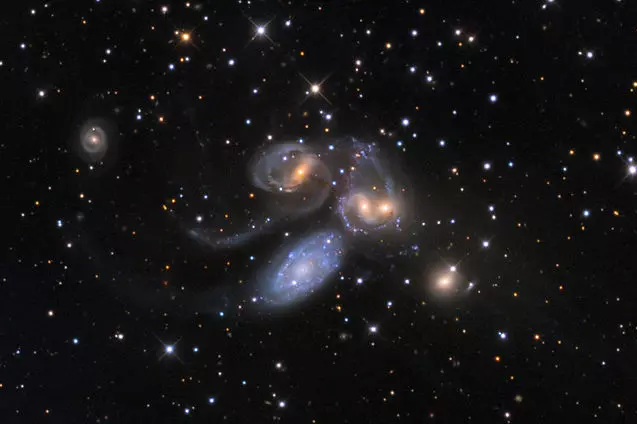
Stephan’s Quintet, image: Adam Block/Mount Lemmon SkyCenter/University of Arizona (CC BY-SA 4.0)
NGC 7317
NGC 7317 has an apparent magnitude of 14.57. It is 0.4’x’.4’ in size. it is classified as a type E4 elliptical galaxy.
NGC 7318
NGC 7318 is a pair of colliding galaxies, NGC 7318a and NGC 7318b, located some 300 million light years away. Their apparent magnitudes are 14.4 and 13.9 respectively.
NGC 7319
NGC 7319 is a spiral galaxy approximately 360 million light years distant. It has an apparent magnitude of 14.1. A quasar was discovered in the heart of the galaxy in January 2005 and its light spectrum suggests that it is billion of light years distant, which caused some controversy because the galaxy is believed to be much closer to us.
The discovery brought into question the assumption that a ‘high redshift’ in a quasar’s light spectrum meant that the quasar was one of the fastest receding objects in the universe, which in turn meant that it was billions of light years distant from Earth.
However, too many quasars have been discovered that were closely associated with galaxies significantly less distant than that.
NGC 7315
NGC 7315 is an elliptical galaxy in Pegasus. It is 1.2’x1.2′ in size and has a visual magnitude of 13.9. The galaxy is notable because a Type Ia supernova, SN 2007B, was observed in it in 2007.
NGC 7742
NGC 7742 is an unbarred spiral galaxy in Pegasus, seen face-on. The galaxy is notable for having a ring, but no bar, which would normally produce the ring structure in the galaxy.
The ring structure in NGC 7742 may be the result of a merger with a small, gas-rich dwarf galaxy, and the exceptionally bright central region and some of the gas rotating in the opposite direction are some of the features that suggest this may have been the case.
NGC 7742 has a visual magnitude of 12.35 and is approximately 72.4 million light years distant from the Sun.
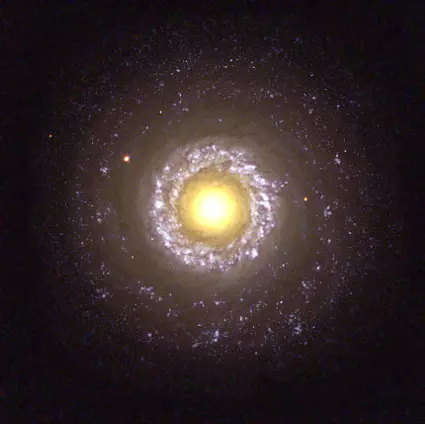
NGC 7742, image: Hubble Heritage Team (AURA/STScI/NASA/ESA)
NGC 7331 (Caldwell 30)
NGC 7331 is a spiral galaxy with a visual magnitude of 10.4, about 40 million light years distant. The galaxy was discovered by the German-born British astronomer William Herschel in 1784. It has a similar structure and size to the Milky Way.
NGC 7331 is the brightest galaxy in the NGC 7331 Group, sometimes also called the Deer Lick Group. What is particularly notable about the galaxy is that its bulge is rotating in the opposite direction to the rest of the galaxy’s disk.
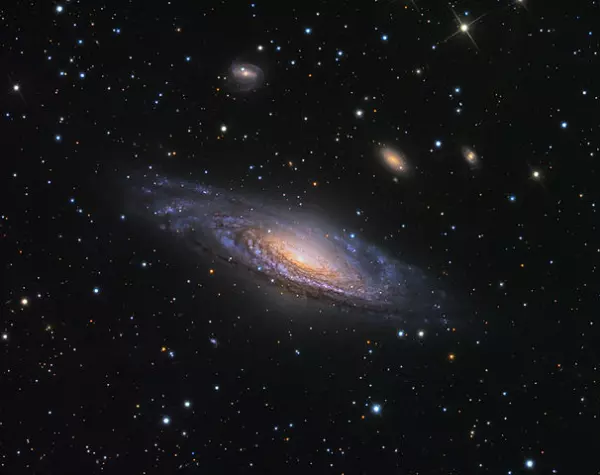
NGC 7331, image: Adam Block/Mount Lemmon SkyCenter/University of Arizona (CC BY-SA 3.0 US)
NGC 7217
NGC 7217 is an unbarred spiral galaxy with an apparent magnitude of 11.0. It is 3.9’x3.2′ in apparent size and lies approximately 50 million light years from Earth.
The galaxy is a gas-poor system. It has several rings of stars of which the outermost is most prominent and contains most of the gas and star forming activity in NGC 7217.
The galaxy is also notable for a number of stars that rotate in the opposite direction to the majority around the galaxy’s core, and for having two quite distinct groups of stars, the young, metal-poor population on the outermost regions and stars of intermediate age on the innermost ones.
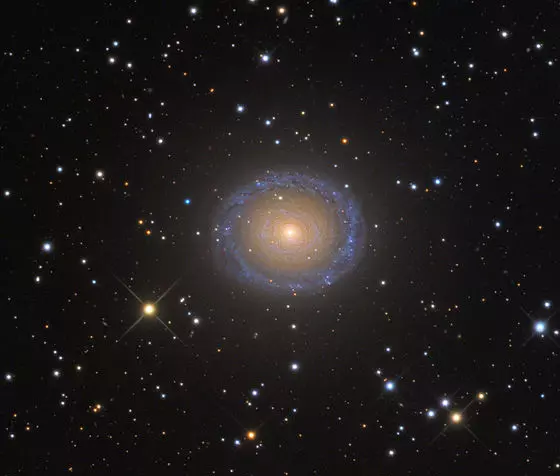
NGC 7217, image: Adam Block/Mount Lemmon SkyCenter/University of Arizona
NGC 7673
NGC 7673 is a disturbed spiral galaxy with a visual magnitude of 13.2, about 1.3’x1.2′ in size. It is a starburst galaxy; one that has recently experienced intense star forming activity. The galaxy is approximately 150 million light years distant.
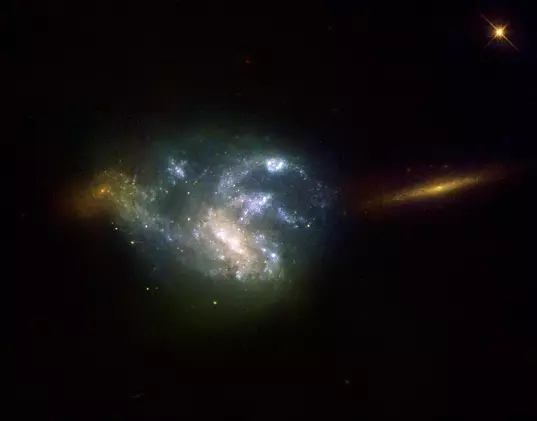
NGC 7673, image: Hubble Space Telescope/NASA/ESA
NGC 23
NGC 23 is a bright spiral galaxy in Pegasus. It is 1.9’x1.4′ in size and has an apparent magnitude of 11.9. The galaxy lies approximately 193 million light years from the solar system.
Einstein Cross (Q2237+030)
The Einstein Cross is a gravitationally lensed quasar located right behind Huchra’s lens, a galaxy named after the American astronomer John Huchra. The phenomenon of gravitational lensing is one of the effects predicted by the general theory of relativity and was originally postulated by Albert Einstein once he realized that gravity would be able to bend light.
The lensing effect is a result of spacetime around massive objects such as black holes or galaxy clusters being curved, which allows rays of light from a source located in the background to be bent. The image of the background source can be distorted and magnified in the process.
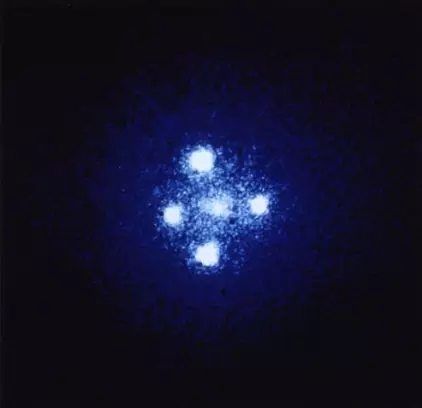
The European Space Agency’s Faint Object Camera on board NASA’s Hubble Space Telescope has provided astronomers with the most detailed image ever taken of the gravitational lens G2237 + 0305 — sometimes referred to as the Einstein Cross. The photograph shows four images of a very distant quasar which has been multiple-imaged by a relatively nearby galaxy acting as a gravitational lens. The angular separation between the upper and lower images is 1.6 arcseconds. Image: NASA, ESA, and STScI
The quasar is called the Einstein Cross because as many as four images of the quasar appear around the galaxy in the foreground as a result of strong gravitational lensing. The quasar is about 8 billion light years distant from the Sun, while Huchra’s lens lies only 400 million light years away.
The exact location of the quasar is at 22h40m30.3 (right ascension), +3°21’30.3” (declination).
NGC 7814 (Caldwell 43, UGC 8)
NGC 7814 is a spiral galaxy in Pegasus seen edge-on. It has an apparent magnitude of 11.6 and is approximately 40 million light years distant.
The galaxy is sometimes called the little sombrero because of its resemblance to the Sombrero Galaxy (Messier 104) in Virgo constellation.
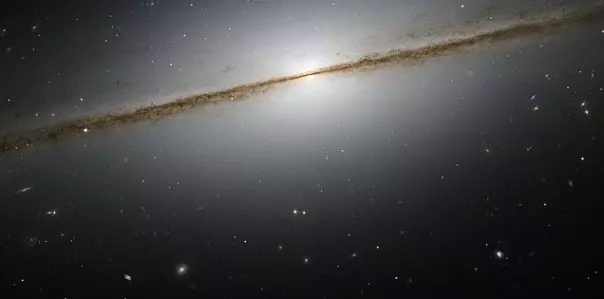
NGC 7814, image: NASA (Hubble Space Telescope)
Propeller Galaxy – NGC 7479 (Caldwell 44)
NGC 7479 is a barred spiral galaxy. It has an apparent magnitude of 11.6 and is located about 105 million light years away in Pegasus. It is classified as a Seyfert galaxy undergoing star forming activity in the core and outer spiral arms.
The galaxy was discovered by the German-born British astronomer William Herschel in 1784. Two supernovae were observed in the galaxy in recent decades, SN 1990U and SN 2009jf.
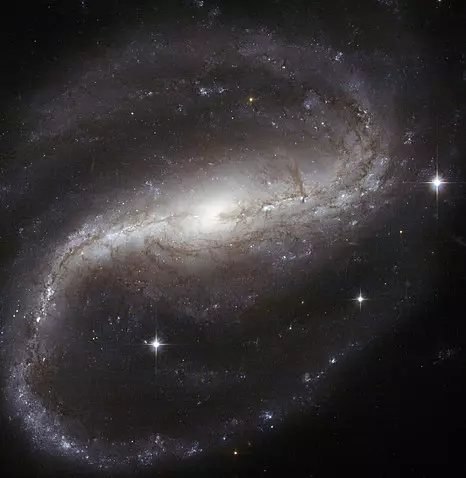
In this Hubble image of Caldwell 44, also known as NGC 7479, the tightly wound arms of the barred spiral galaxy create a backward “S” as they spin in a counter-clockwise direction. However, this galaxy, nicknamed the Propeller galaxy, emits a jet of radiation in radio wavelengths that bends in the opposite direction to the stars and dust in the arms of the galaxy. Astronomers think that the radio jet was put into its bizarre backward spin after the Propeller galaxy merged with another galaxy. The Propeller galaxy is an interesting subject for several other reasons as well. Hidden within the galaxy’s core lurks a supermassive black hole that feeds on large quantities of gas. The galaxy has also been the home to two recent supernovae, one witnessed in 1990 and the other in 2009. Image: NASA (Hubble Space Telescope)
NGC 1
NGC 1 is a spiral galaxy in Pegasus, about 90,000 light years in diameter. It has a visual magnitude of 13.65 and is approximately 206 million light years distant.
It was the first deep sky object to be entered in the New General Catalogue (NGC). When the catalogue was compiled, objects were arranged by right ascension, and NGC 1 had the lowest right ascension at the time (00h07m15.86s). Coordinates have shifted since and this is no longer the case.
NGC 7725 and NGC 7753
NGC 7725 and NGC 7753 are a pair of galaxies in Pegasus. NGC 7753 is a barred spiral galaxy and NGC 7753 is its satellite galaxy, a barred lenticular galaxy that appears to be attached to one of NGC 7753’s arms.
The galaxies have visual magnitudes of 15.0 and 12.8 and are approximately 272 million light years distant from the solar system. A supernova, SN 2006A, was observed in NGC 7753 in January 2006.